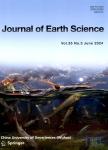Evolution of Low-Angle Normal Faults in the Enping Sag,the Northern South China Sea: Lateral Growth and Vertical Rotation
Evolution of Low-Angle Normal Faults in the Enping Sag,the Northern South China Sea: Lateral Growth and Vertical Rotation作者机构:Key Laboratory of Tectonics and Petroleum Resources of Ministry of EducationChina University of GeosciencesWuhan 430074China Research Institute of Exploration and DevelopmentPetroChina Tuha Oil Field CompanyHami 839000China Shenzhen Branch of the China National Offshore Oil CorporationShenzhen 518000China
出 版 物:《Journal of Earth Science》 (地球科学学刊(英文版))
年 卷 期:2019年第30卷第6期
页 面:1326-1340页
核心收录:
学科分类:070801[理学-固体地球物理学] 07[理学] 0708[理学-地球物理学] 0704[理学-天文学]
基 金:supported by the Major National Science and Technology Programs China (Nos. 2016ZX05026-003-001 and 2011ZX05023-001-015)
主 题:low-angle normal fault fault rotation fault growth Enping sag Pearl River Mouth Basin the South China Sea
摘 要:Low-angle normal faults(dip30°,LANFs)are widespread in the northern margin of the South China Sea where the maximum crust thickness is approximately 30.0 km.Based on 3 D seismic survey data and drilling wells in the Enping sag,evidences for LANFs that initially formed at high-angles are discussed.After a detailed investigation of extensional fault system and description of 3 D fault geometry,the initial fault dips under the model of distributed vertical simple shear are also calculated.The results indicate that the present-day dip angles of the LANFs are in the range of 12°to 29°,and the initial fault dip angles are in the range of 39°to 49°.Deep seismic imaging suggests that the upper crust in the footwall block of the LANFs was tilted at an angle of ~14°to 22°due to the isostatic rebound during rifting.Moreover,the temporal and spatial sequences of the lateral growth of the LANFs have been investigated by the seismic interpretation of four isochronous stratigraphic interfaces,which demonstrates that two individual fault segments propagated towards each other and subsequently,were hard-linked during the Early Eocene.



